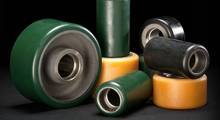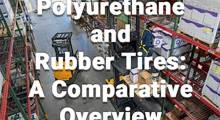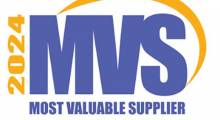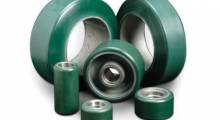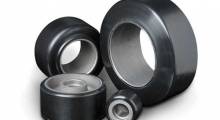HARTING Logistics
Location: Espelkamp, Germany
Square Footage: 614,835 square feet
Products Handled: Parts and components for industrial automation, including industrial connectors, PSC connectors, industrial interface connectors, system cabling and industrial Ethernet switches
SKUs: 30,000
Throughput: The facility ships up to 10,000 parcels per day to customers and other HARTING facilities.
Shifts: 3 shifts per day, 5 days per week
Read the HARTING System Report feature article here.
HARTING’s new distribution center brings together vertical lift modules, shuttles, mini-loads and pallet-handling automated storage and retrieval systems (AS/RS); automatic guided vehicles (AGVs); automatic depalletizing and palletizing, and RFID technologies for efficient, ergonomic and energy efficient operations.
Receiving
There are two major inbound flows. About 70% of incoming product is from HARTING’s own production. The remainder comes from external suppliers and comprises products such as cables and connectors that HARTING may not make. When a load is palletized in a HARTING facility, the information of what’s on the pallet is uploaded into the inventory system; incoming pallets have a license plate RFID tag that itemizes the number of bins on the pallet and the product in each bin. The bins themselves have an identifying bar code.
When a lift truck unloads a HARTING pallet, an onboard RFID reader automatically scans the tag. The system then tells the operator where to stage the pallet in the receiving area. Pallets from external suppliers are manually scanned and then directed to a staging area.
Pallet storage
Some pallets will be stored as is in a pallet-handling AS/RS with 7,000 storage locations. AGVs deliver the pallets to an induction station for the AS/RS. Once they are put away by cranes, they are available to promise.
Depalletizing
Product that will be stored in bins or cartons is delivered by AGVs to a depalletizing/palletizing machine. During the depalletizing process, the machine picks up the whole load from the pallet. Once the pallet is automatically pushed away, the machine deposits one layer at a time onto the conveyor. As bins leave the depalletizing area, they pass over a weight check scale. If the scale can read the bar code label on the bin and the weight is within tolerances, the box is ready for putaway into storage. Otherwise, it goes to a workstation for a manual inspection.
Putaway/Storage
Bins are prioritized based on velocity. The 500 fastest-moving SKUs that represent about 60% of the daily workload are stored in standard shelving. Think of these as A+ movers. A and B and C movers are stored in a mini-load AS/RS with 10 cranes and 115,000 storage locations. The fastest moving A movers are in an area of the mini-load serviced by two cranes stacked on top of one another. The area is also condensed so the cranes don’t have to travel long distances to execute a task. That allows for very fast replenishment and retrieval in that area. The B and C movers are stored in a section serviced by one crane per aisle. As with the pallets, once a bin is in a storage location, it’s available to promise.
Picking
There are two types of picking stations: Those designated for full pack picks and those for mixed pack, or mixed case, orders.
Full pack orders are picked in a fast-picking area. To fulfill this type of order, a target bin is conveyed from the fast-picking storage area to a workstation. There, an associate picks a package to a target bin and presses a button to confirm the pick. In all, the pick and confirmation takes a few seconds. The fast-picking area is serviced by a circulating conveyor so bins can be staged to keep a steady flow of target bins to the workstations.
Multi-line orders are batch picked at workstations in another area. In this area, items are picked by article. For example, when the bin for the first item in a three-item order arrives at the workstation, an associate picks the number of that SKU required for that order. The system then checks to see if any other outstanding orders are available for that item. If so, items are picked to other totes. Once all of the quantities for which there are orders have been picked, or the bin is empty, the target bin is either returned to storage or the empty is sent for cleaning and reuse. At that point, the target bins are sent to a shuttle system that serves as temporary buffer storage until all the items for an order have been picked and are ready for consolidation at a packing station.
Packing
Full pack orders that ship in their original packaging go directly to packing; or, if they are part of a multi-line order, go to buffer storage to be consolidated later. At packing, the system prints out any required delivery instructions followed by a handling label that informs the shipping sorter and conveyor system to which delivery channel—DHL, FedEx, UPS, etc.—the package is destined for. The system also checks the weight of the package and prints any shipping and content labels that are required. Finally, labels are scanned and checked for readability. Conveyors are not fixed: They can be re-assigned based on availability. Once shipping labels have been prepared and the weight has been checked, the package is conveyed to a palletizing and shrink wrap area. From there, it is delivered to the shipping area.
To complete a multi-line order, the shuttle system staggers the release of the bins required for an order based on the time required for that bin to reach a packing station. For example, heavier bins travel slower than lighter weight bins and will be released first. The system can release a bin every two seconds.
At the pack station, an associate packs the items required for an order into a shipping container. The items in the container are photographed for verification of what was packed and shipped. Once the last item has been packed, the system prints a delivery note. From there, the same steps are followed as for a full pack order before the order is conveyed to the palletizing area.
Shipping
Pallets are delivered from the shrink-wrap area to a staging area. RFID tags embedded in the floor automatically read the license plate RFID tag on a pallet when it’s placed in a staging location. When it’s time to load a pallet onto an outbound trailer, an RFID reader at the shipping dock reads the pallet and confirms with a green or red light that the pallet is being loaded onto the correct outbound trailer.
System suppliers
- System Integration & Project Management: Koerber AG
- System Design & Materials flow: HARTING and Fraunhofer Institute for Material Flow and Logistics IML
- ERP, WMS & WCS: SAP
- Pallet-Handling/RS Cranes: Dambach Lagersysteme GmbH & Co. KG
- Mini-Load AS/RS Cranes & Conveyor: TGW Logistics Group GmbH
- Shuttle System: Knapp AG
- Vertical Lift Module: Hanel Storage Systems
- Racking System: Lampe Lagertechnik GmbH
- Palletizer & Depalletizer: Schwingshandl
- Stretch Hood System: Beumer Group
- AGVs: EK Automation
- Lift Trucks: Linde
- RFID Technology, Including Mobile RFID for Lift Trucks: HARTING
- Cleaning System for Reusable Containers: Hobart GmbH
Article topics


